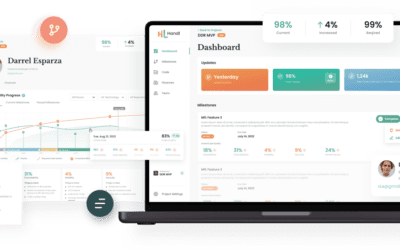
I like to think of great product roadmaps kinda like cooking a delicious dish.
You start off with a recipe, a clear idea of what the end product will look like.
But along the way unexpected problems change your course — a missing ingredient, a wrong measurement, someone doesn’t like onions.
You’re forced to alter your recipe based on these new parameters.
And, if done right, you end up with something that resembles the original recipe but is much more delicious.
But if you stick to the recipe too closely, your dish will be missing some key ingredients and might come off bland.
Equally, deviate too far from the recipe and your dish might be, well, inedible.
Building a product roadmap is exactly like this. So many competing priorities are vying to influence and alter your product’s course (for better or worse).
And just like cooking, if your product roadmap is too rigid, it’ll break down when something changes. If it’s too flexible, it won’t hold anything together.
Great product roadmaps need to move and flex as the environment changes around them.
So how do you know how flexible or rigid to be when it comes to building a product roadmap
That requires an understanding of what factors can influence your product’s refinement – and how. So here they are…
Founders + friends

Founders and business owners (aka you) have their own ideas and biases about how a product should operate. And these beliefs unquestionably inform your product’s evolution.
But it’s not just their views, it’s the views of the people around them — friends, family, associates. They’ve all got their opinions about how the product should work and what’s most important to focus on.
As a product owner, it’s on you to manage all these opinions and biases because it’s your product after all, right?
Surveys + Stats

Both quantitative and qualitative inputs play a huge role in your product’s early development and they should absolutely be factored into your product’s roadmap. That’s because they offer insights into what the market wants out of your product.
On the flip side, there’s always a new feature, innovation, or hot piece of tech, so it pays to be realistic about the insights you glean.
Competition

Often the fastest path to new customers is to understand what customers hate about a competitor. What’s their biggest bugbear, what are other products missing?
What significant product feature would be worth customers’ effort to switch products?
Early customers

Early customers are the first sign you’re onto something. Someone’s actually paying for your product!
Often though, early customers can lead you astray.
You’ve got to keep early customers happy because they’re sure money. But trying to keep these customers happy can often direct your product roadmap in a new direction.
Are you staying true to the idea you’re trying to solve? Or is an early customer pushing you in a direction that’s not in your business’ best interests?
Analytics

At the beginning of your product’s life, external stats and surveys are your north star. They help you understand what your customers want, how they behave, and where you can differentiate yourself from competitors.
But as you start to gain customers and grow, looking inward and analysing your product becomes just as impactful.
Analytics tools — (Specifical traffic tools) Google analytics, support stats, etc — help you to understand how potential customers are responding to your marketing and what problems existing customers are having with your product.
User behaviour tools & heat mapping tools that tell you how your customers behave and interact with your products and marketing. (Think HotJar, FullStory etc)
All of these insights can help you identify where your product, business model, and messaging can be refined.
Investors

Investors bring a huge upside to your business: they come with money, their own experiences and understanding, and often connections and partnerships.
But, just like founders and owners have biases, investors come with their own set too. In the same way that a demanding first customer can steer your product roadmap in a less-than-ideal direction, so too can an overzealous investor with their own ideas of what your product should be.
Tech debt and product maintenance

Tech debt — the parts of your product that need fixing or updating — is often something that’s left off a product roadmap because it’s not seen as “new” or “exciting” or “cost-saving”. But if ignored, it’ll come back to bite you hard.
You need to make sure that it’s factored into the product roadmap so you’re not operating on a “spin up and move on” product basis. Because when it comes time to update your system or release a new feature, all the little things that you’ve ignored will come back to slow the process and limit your ability to deliver what your customers are asking for.
I go into detail about the perils of bad first-time code and tech debt here.
Your team

As you grow, your own team will have their own opinions on which parts of your product roadmap should be prioritized.
Maybe your support team needs better tools to do their job.
Maybe the sales team has over-promised a feature and wants it prioritized.
Or switching to a more cost-effective host provider might save you a ton of cash.
Internal teams with competing interests will advocate for their “product enhancements” to be at the top of the list. It’s your job to keep a clear head and identify which are critical and which are just nice to have.
Future clients

In the early day of your product’s development, you’re building for a handful of customers that have an immediate need — the low hanging fruit.
But as your product evolves, you’ll begin to appeal to a wider group of future customers from different places. For instance, early on your product’s audience might have been smaller businesses. More and more clients are now coming from corporates.
And this change is significant because it shifts who your audience is, and which elements of your product are appealing. For example, if large corporations become interested in your product, things like support and pricing take more of a front seat than they had been for those early customers.
Point is, these future customers come with expectations that your product will be more refined than your early adopters. But understanding exactly which product changes you need to make is often like hitting a moving target.
The secret is constant feedback loops and a lot of hard work. The cliched “test, learn, refine, and repeat” is your fastest path to understanding what future customers want and what they don’t.
User feedback

User feedback is massive. It should be done constantly — from your product’s launch and through every new update and feature. You should be asking and answering questions like:
- How are customers using your product?
- How are you speaking to them?
- Have you had any sessions where you can sit and watch your user?
- Do your customers use your product the right way?
- What phone, device or screen are they using?
- What makes their experience different from everyone else’s?
This level of customer curiosity must be embedded in your product from the start because as your product changes, so too will the way your customers interact with your product.
It’s okay for your product roadmap to zigzag
Your product roadmap isn’t just about your opinion or the tech behind it. It’s about how you take in all of these other influences and apply them to your product. Think of yourself as the filter that lets good ideas through and blocks bad influences from hijacking the direction of your product. Because at the end of the day it’s your product and you’re going to be responsible for its effectiveness.

If you take one thing from this blog…
Remember the key way to think about your product roadmap is that any change you make must balance the needs of your business with the needs of your people and customers.




